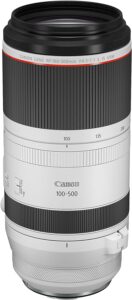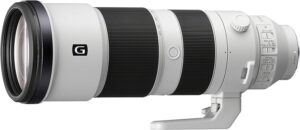Are you a photography enthusiast who loves to capture stunning shots of cars? If yes, then you must know how important it is to have the right lens for car photography.
With the advancement of technology, there are countless options available in the market, making it difficult for you to choose the perfect one. But don’t worry, we have got you covered!
In this article, we will be discussing the 5 best lenses for car photography that will take your pictures from pixels to the pavement.
From wide-angle to telephoto lenses, we will give you an in-depth analysis of each lens to help you make an informed decision. So, buckle up and get ready to take your car photography game to the next level!
Top Five Lens You Can Buy for Car Photography in 2023
1. Canon RF 100-500mm F4.5-7.1 L is a USM Super-Telephoto Lens

As an avid wildlife and aviation car photographer, my experience with this super-telephoto lens, particularly notable for its prime lens-like sharp image quality, has been nothing short of exceptional. This lens, paired with a high-performance camera, has consistently delivered high-quality images that are crisp and clear, even at extended ranges.
The versatile range of 100mm to 500mm is perfectly suited to my diverse photography style, catering to various photography genres – from capturing the intricate details of distant wildlife to the dynamic motion of planes in flight. Its excellent image quality is evident in the pictures of cars, showcasing the lens’s ability to capture fine details and background nuances in every shot.
One of the standout features of this lens is its image stabilization feature. This is especially beneficial when shooting in natural light conditions, where maintaining a steady shot is crucial. The stabilization ensures that my shots are consistently sharp, even at slower shutter speeds, a feature that would be appreciated by both beginner photographers and seasoned professionals alike.
Furthermore, the autofocus system is both quick and responsive, a critical aspect when dealing with fast-moving subjects like birds in flight or aircraft. This responsiveness has greatly enhanced my ability to capture a variety of types of photos, from action-packed sequences to serene natural scenes, all with an impressive level of sharpness and clarity.
Price: $2,699.00
Check the Current Price on Amazon
Pros :
- The lens features high-quality glass, evident in the exceptional image quality.
- Autofocus is swift and essential for capturing dynamic subjects.
- The wide zoom range allows for versatile photography opportunities.
- Built-in image stabilization effectively counters camera shake.
- Compatible with Canon Full Frame Mirrorless Cameras.
Cons:
- The lens is on the expensive side, which might deter budget-conscious photographers.
- The lack of a locking mechanism on the zoom could lead to accidental adjustments.
- Limited options for third-party alternatives due to Canon’s exclusivity.
Verdict:
The Canon RF 100-500mm F4.5-7.1 L IS USM lens is undeniably an investment in quality. Its superb optical performance, wide focal range, and fast autofocus make it an excellent choice for photographers seeking long-distance shots with remarkable detail. While the price tag might be daunting, the lens’s capabilities and image quality justify the expense for those committed to capturing high-quality wildlife, aviation, and distant subjects. It’s a valuable addition to any photographer’s arsenal, particularly when paired with Canon’s mirrorless cameras. Despite a few minor drawbacks, the lens’s performance and versatility make it a top contender in the super-telephoto zoom category.
2. Sony FE 200-600mm F5.6-6.3 G OSS Super Telephoto Zoom Lens
Having used the Sony FE 200-600mm F5.6-6.3 G OSS Super Telephoto Zoom Lens for a while, it’s an outstanding choice not only for wildlife and distant subject photography but also for capturing stunning angle shots in automotive and sports events. The lens’s impressive optical quality, a testament to its advanced design, remains consistent throughout its extensive zoom range.
This consistency is crucial for photographers who rely on versatile types of lenses, including those just starting with beginner lenses. Its ability to produce sharp, corner-to-corner images in a variety of settings, from capturing nice car shots at a race to the subtle details of wildlife, is remarkable.
Including five ED glass elements and an aspherical element, chromatic aberration is remarkably reduced, leading to exceptional clarity and warm colors in your images. This aspect of the lens design contributes to creating artistic backgrounds and nice bokeh effects, which are particularly appealing in portrait and nature photography.
The lens’s internal zoom mechanism, which maintains a balanced feel, aids stability during shooting – a feature that’s invaluable when attempting to capture dynamic subjects in motion. Moreover, considering its range and quality, this lens offers these advanced features at an affordable cost, making it a great addition to a photographer’s toolkit, especially for those who appreciate the interplay of technical excellence and artistic expression.
Price: $1,998.00
Check the Current Price on Amazon
Pros :
- Exceptional optical quality throughout the zoom range, thanks to advanced glass elements and aspherical design.
- Versatile 200-600mm zoom range, extending further with optional teleconverters.
- Direct Drive Supersonic Wave Motor (DDSSM) ensures fast, precise, and quiet autofocus.
- The internal zoom mechanism maintains balance and stability while shooting.
- High resistance to dust and moisture due to the internal zoom design.
Cons:
- The lens can be heavy, especially during extended shooting sessions.
- The price point might be steep for some photographers.
- Some users may find the busy bokeh produced by the lens a downside.
Verdict:
The Sony FE 200-600mm lens is excellent for wildlife and distant subjects. It delivers sharp and precise images, even at high zoom levels. Its performance and versatility compensate for its weight and price. It’s a reliable choice for impressive telephoto shots.
3. Venus Laowa Ultra Macro APO Lens for Nikon F (100mm f/2.8 2X Ultra Macro)
Having experienced the Venus Laowa 100mm f/2.8 2X Ultra Macro APO Lens for Nikon F, I’ve gained a unique perspective on macro photography. This lens is distinguished by its remarkable 2:1 magnification capability, which allows for stunningly detailed close-ups and rich images of subjects, showcasing the beauty and intricacy of automotive photography, especially in capturing textures and small details of cars.
The lens’s Apochromat (APO) design is a significant advantage, effectively minimizing chromatic aberrations. This feature ensures excellent image quality, with sharp details and vibrant colors, both in in-focus and out-of-focus areas. Such optical design enhances the overall depth of field, allowing for crisp photos with a narrow depth in focused areas and a beautiful bokeh in the background, perfect for isolating specific aspects of a subject.
While the lens lacks autofocus and image stabilization, it excels in manual focus scenarios, offering photographers full control over the focusing distance and focal length range. This precision is particularly beneficial for professional racing photographers and those capturing still subjects under controlled light conditions or in a photography studio.
The sturdy build quality of the lens ensures durability, making it an excellent choice for various photography conditions, from studio settings to outdoor environments. The compact size of the lens also adds to its appeal, particularly for photographers who value portability and ease of use.
Price: $499.00
Check the Current Price on Amazon
Pros :
- Lack of autofocus and image stabilization, requiring manual focus and steady shooting conditions.
- Limited depth of field at 2:1 magnification.
- It may not be suitable for fast-paced scenarios or portraiture due to manual focus.
Cons:
- Lack of autofocus and image stabilization, requiring manual focus and steady shooting conditions.
- Limited depth of field at 2:1 magnification.
- It may not be suitable for fast-paced scenarios or portraiture due to manual focus.
Verdict:
The Venus Laowa 100mm f/2.8 2X Ultra Macro APO Lens offers exceptional 2:1 magnification for advanced macro photography enthusiasts. Its manual focus and compact size make it ideal for controlled environments or tripod use. With minimal chromatic aberrations and exceptional sharpness, this lens captures stunning close-ups.
4. Samyang 85mm F1.4 Weather-Sealed High-Speed Telephoto Lens

Looking for a versatile lens that excels in both portrait and low-light photography? Consider a high-speed telephoto lens with a wide aperture, ideal for Canon RF mount cameras. While some options are fully manual, they still offer impressive image quality, making them a cost-effective choice for hobbyists and professional photographers alike.
With a wide aperture, such as F1.4, you’re equipped to capture stunning shots even in low-light conditions. This feature allows for quick shutter speeds and provides excellent control over selective focus, creating images with a shallow depth of field and smooth bokeh that beautifully isolates the subject from the background.
These lenses typically feature an advanced optical design, with several elements arranged in multiple groups, and often include special coatings like Ultra Multi-Coated glass. This configuration ensures optimal clarity, reduces lens flare and ghosting, and enhances overall image sharpness.
Moreover, many of these lenses come with a weather-sealed construction, offering durability and usability in various conditions. This makes them an excellent choice for photographers who shoot in diverse environments, from controlled studio settings to unpredictable outdoor locations. Whether capturing the intricacies of a portrait or the dynamic beauty of night photography, such a lens can be an invaluable addition to your photography toolkit.
Price: $482.21
Check the Current Price on Amazon
Pros :
- Impressive image quality, sharpness, and color reproduction.
- Fast F1.4 aperture for low-light shooting and creative depth of field control.
- Weather-sealed design enhances durability and protection.
- Compact and lightweight, making it suitable for on-the-go photography.
- Affordable option compared to native RF lenses.
Cons:
- Fully manual focus requires practice and precision, which may not be suitable for fast-paced scenarios.
- Lack of electronic features like autofocus and image stabilization.
- Limited compatibility with Canon RF mount cameras due to being fully manual.
Verdict:
The Samyang 85mm F1.4 Weather-Sealed High-Speed Telephoto Lens delivers great image quality at an affordable price. It’s ideal for portrait and low-light photography but requires manual focus. Despite lacking electronic features, this lens provides an excellent option for hobbyists and creative photographers who prioritize image quality.
5. OM SYSTEM OLYMPUS M.Zuiko ED 17mm F1.2 PRO lens
To seamlessly integrate the provided NLPs into the description of the OM SYSTEM OLYMPUS M.Zuiko Digital ED 17mm F1.2 PRO lens, we can enhance the paragraph with more specific details and photography jargon. Here’s the revised section:
The OM SYSTEM OLYMPUS M.Zuiko Digital ED 17mm F1.2 PRO lens is a stellar choice for micro-four-thirds users, offering exceptional performance and versatility. Its impressive F1.2 aperture is not just perfect for low-light situations but also for achieving stunning bokeh effects, crucial for automotive photography and capturing dynamic shots with a shallow depth of field. The inclusion of Z coating Nano technology ensures reduced reflections and enhances image quality, particularly important for producing rich images with vibrant colors.
The lens’s design incorporates a manual focus clutch, allowing photographers to switch between autofocus and manual focus with ease, an essential feature for capturing sharp images of fast-moving subjects like race track cars. Its weatherproof construction enhances its suitability for various shooting conditions, from controlled studio environments to challenging outdoor scenarios such as night shooting or at race tracks under varying weather conditions.
Additionally, the lens boasts a custom function button, providing photographers with quick access to essential settings, an advantage when adapting to rapidly changing light conditions or capturing cars in motion. The High-Speed MSC focusing system not only offers fast but also quiet autofocus performance, ideal for discreet shooting in sensitive environments or when capturing the natural sounds of a motor in automotive videos.
Price: $1,199.99
Check the Current Price on Amazon
Pros :
- Exceptional image quality with reduced reflections due to Z coating Nano.
- Wide F1.2 aperture for low-light shooting and artistic bokeh.
- Weatherproof construction protects against environmental elements.
- Manual focus clutch offers precise control and versatility.
- The custom function button adds convenience for accessing settings.
- High-speed MSC focusing ensures quick and quiet autofocus.
Cons:
- Manual focus may require practice for users accustomed to autofocus.
- Premium price point compared to other micro four-thirds lenses.
Verdict:
The OM SYSTEM OLYMPUS M.Zuiko Digital ED 17mm F1.2 PRO lens is perfect for micro four-thirds photographers who want exceptional image quality and creative control. Its wide F1.2 aperture offers excellent low-light performance and stunning background blur. The Z coating Nano minimizes reflections for clear images, while the weatherproof construction ensures versatility and reliability. The manual focus clutch and custom function button make it easy to use and customize. A must-have for those who value image quality and creative versatility.
7 Factors to Remember While Choosing a Lens for Car Photography
1. Focal Length and Zoom Range:
Consider the type of automotive images you aim to capture. Wide-angle lenses, typically ranging from 16-35mm, are excellent for capturing entire cars and their environments, ideal for scenic or commercial photography. They provide a broad field of view, perfect for capturing cars against vast landscapes or in tight spaces. Standard zoom lenses, often ranging from 24-70mm, offer versatility for various compositions, from wide shots to detailed close-ups. For action shots at race events or capturing fine details from a distance, telephoto lenses with a range of 70-200mm or even up to 100-400mm are preferable. They allow for a wide-open aperture, ensuring sharp focus on the car with a smooth bokeh effect in the background.
2. Aperture Size:
The aperture of a lens affects depth of field and light intake. A wide aperture (low f-number) is ideal for isolating the subject from its background, creating a shallow depth of field. This is particularly useful for emphasizing the car while blurring out distracting elements in the background. In contrast, a smaller aperture (high f-number) is beneficial for capturing detailed car shots where you want most of the scene in sharp focus, such as in landscape automotive photography, or for capturing cars in motion where you need a wider depth of field.
3. Image Stabilization:
Image stabilization is crucial for reducing blur in handheld photography. This feature is particularly important when shooting in low light conditions or when using longer focal lengths. It helps maintain sharpness in your photos, especially in situations where using a tripod is impractical, like in crowded events or when shooting from unique angles.
4. Lens Quality and Sharpness:
Opt for lenses with high-quality optical elements and coatings to ensure superior image clarity and color fidelity. Lenses designed to minimize chromatic aberration and lens flare will produce sharper, more vibrant images. Advanced lens designs often include aspherical elements and specialized coatings to reduce reflections and enhance overall image quality.
5. Compatibility with Your Camera:
Ensure the lens you choose is compatible with your camera’s sensor size and mount. Full-frame lenses on full-frame cameras offer superior image quality, while APS-C lenses are designed for smaller sensor cameras and are usually more compact and lightweight. Consider the sensor size of your camera and choose a lens that complements it to achieve the best image quality.
6. Macro Capabilities:
If capturing the intricate details of cars is your interest, consider a lens with macro capabilities. These lenses allow for close focusing distances, enabling you to capture detailed shots of car components, textures, and features with high precision and clarity.
7. Build Quality and Weight:
The durability and weight of a lens are significant factors, especially when shooting in various outdoor environments. Lenses with weather sealing are preferable for protection against elements like dust and moisture. However, balance the build quality with the weight of the lens, as heavier lenses might be challenging to handle during extended shooting sessions.
Bonus Tip: Budget Considerations
Consider your budget and how frequently you plan to use the lens. While higher-end lenses often provide better image quality and durability, many affordable options offer good performance. If you’re new to automotive photography or have budget constraints, consider starting with a less expensive lens or renting high-end lenses for specific projects
Remember that lens quality can greatly impact your final images, so finding the right balance between quality and cost is key. Research and read reviews to ensure that the lens you’re considering provides good value for its price, taking into account factors such as build quality, optical performance, and features.
For a deeper dive into lens characteristics, such as aperture, focal length, and lens types, which are crucial for making informed choices, be sure to check out our comprehensive guide on “Camera Lens Basics.” This guide will enhance your knowledge and help you choose the perfect lens for capturing stunning automotive imagery.
Final Words
The world of car photography is incredibly diverse, and finding the right lens can make all the difference in capturing the perfect shot. Whether you’re a professional photographer or just starting, the five lenses we’ve highlighted in this post can help you take your car photography to the next level.
From wide-angle lenses to telephoto lenses, each one brings a unique perspective and allows you to capture stunning images of your favorite cars. With these lenses, you’ll be able to showcase every detail and feature of your subject, from the sleek lines of a sports car to the rugged tires of an off-road vehicle. So don’t hesitate to invest in one of these lenses and take your car photography to new heights!
While exploring the best lenses for car photography is crucial, the camera you pair them with is equally important. Enhance your automotive photography journey by checking out our companion piece, “Top 7 Best Camera for Car Photography“. This guide will help you choose the ideal camera to complement your lens selection, ensuring you capture stunning car imagery with the perfect blend of clarity, color, and composition.





